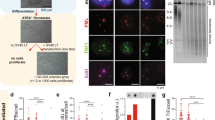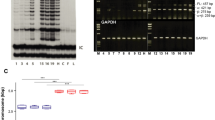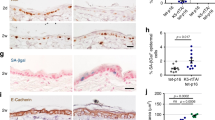Abstract
Li-Fraumeni Syndrome (LFS) is characterized by heterozygous germline mutations in the p53 gene. Accompanied by genomic instability and loss or mutation of the remaining wild type p53 allele, a low frequency of spontaneous immortalization in LFS fibroblasts occurs. It is believed that the loss of p53 wild type function contributes to immortalization of these LFS fibroblasts, but it is not clear if this is sufficient. Because stabilization of telomere length is also thought to be a necessary step in immortalization, telomerase activity, expression of the telomerase RNA component (hTR) and telomere length were analysed at various passages during the spontaneous immortalization of LFS skin fibroblasts. One LFS strain which immortalized, MDAH087 (087), had no detectable telomerase activity whereas another LFS strain which immortalized, MDAH041 (041), had detectable telomerase activity. In preimmortal cells from both strains, hTR was not detected by in situ hybridization. Immortal 087 cells remained negative for hTR, while immortal 041 cells demonstrated strong hTR in situ hybridization signals. 087 cells had long and heterogenous telomeres whereas telomeres of 041 cells had short, stable telomere lengths. Tumorigenicity studies in nude mice with ras-transformed 087 and 041 cells resulted in both cell lines giving rise to tumors and retaining telomerase status. Overall these results suggest that strain specificity may be important in telomerase re-activation and that both abrogation of p53 function and a mechanism to maintain telomeres are necessary for immortalization.
This is a preview of subscription content, access via your institution
Access options
Subscribe to this journal
Receive 50 print issues and online access
$259.00 per year
only $5.18 per issue
Buy this article
- Purchase on Springer Link
- Instant access to full article PDF
Prices may be subject to local taxes which are calculated during checkout
Similar content being viewed by others
Author information
Authors and Affiliations
Rights and permissions
About this article
Cite this article
Gollahon, L., Kraus, E., Wu, TA. et al. Telomerase activity during spontaneous immortalization of Li-Fraumeni syndrome skin fibroblasts. Oncogene 17, 709–717 (1998). https://doi.org/10.1038/sj.onc.1201987
Received:
Revised:
Accepted:
Published:
Issue Date:
DOI: https://doi.org/10.1038/sj.onc.1201987
Keywords
This article is cited by
-
Critical pathways in cellular senescence and immortalization revealed by gene expression profiling
Oncogene (2008)
-
Establishing and characterizing human periodontal ligament fibroblasts immortalized by SV40T-antigen and hTERT gene transfer
Cell and Tissue Research (2006)
-
Human fibroblasts require the Rb family of tumor suppressors, but not p53, for PML-induced senescence
Oncogene (2004)
-
Epigenetic silencing of multiple interferon pathway genes after cellular immortalization
Oncogene (2003)
-
Alternative lengthening of telomeres in mammalian cells
Oncogene (2002)



